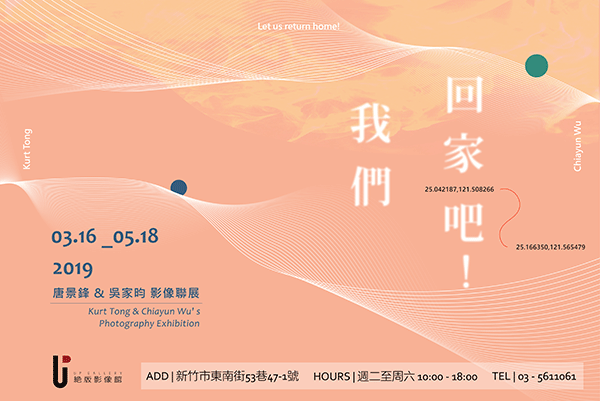EXHIBITIONS
Exhibitions ─ previous
“Let us return home!” Kurt Tong & Chiayun Wu Group Exhibition
“Let us return home!” Kurt Tong & Chiayun Wu Group Exhibition
Dates|2019.03.16 – 2019.05.18
Opening Reception|2019.03.16 (Sat.) 14:30
Venue|UP Gallery
Artists|Kurt Tong & Chiayun Wu
Recently other forces suggest to be at play, drastically changing the image making process. As Begg classifies in Third Text: Critical Perspectives on Contemporary Art & Culture, detterritorialisation, hyper-capitalism and time-space compression are the factors of globalisation.1 These factors melt down the original conceived barriers and cause a new set of momentums that direct the current artistic practice of image making into new heights. In this exhibition, UP Gallery seeks to present works that sculpt the contemporary state of self-realization and understanding of identity influenced under different sets of attributes that are meaningful for the current social state in a larger entity.
Mediascapes as Appadurai coins is one dimension of global culture flows that effect perceptions of culture through the distribution of electronic capabilities and its function to disseminate information.2 Movies, TV Shows and idealized photography projects of China, these Mediascapes were initial knowledge for Tong which formed an image of his roots. Simultaneously mixed with stories retold by relatives as Hirsch would define part of the Postmemory process, Tong sets out on a journey to connect with his roots to find an identity.3 Born in Hong Kong but spending the majority of his time away from home, in Sweet Water Bitter Earth, Tong creates images with a 80s Chinese Camera. Through the series he presents landscapes that hold significant connection to his cultural roots but only to find fragile links to his personal memories. The travel routes taken in China were random and laced with a sense of emotional failure. The drastic change of China and total alienation of his initial image of his motherland resulted in submerging negatives in the sea along the routes of his paternal ancestor’s. Whilst imprinting the images by walking on them with local earth of his maternal side. The natural exposure and the imposed decay signifies the attempt to mend the little connection with these places, bringing out a body of delicate images through the process.
Chiayun Wu on the other hand delves into reconstructing the memory of her country while studying abroad. Ethnoscapes, which explains the effect that the shifting population has on culture may comprehend the practice of the ten motion light boxes in the exhibition.4 The original images are photographs of Taiwan filmed before Wu left the country. Incorporated with these black and white photos are shapes and colors that mimic the lost warmth and excitement of the memory of these places. As part of the shifting population the new environment and the culture that surrounds her while in London blurs the memory of her homeland. The shapes and colors in the light boxes beat in the frequency of her heart and the tempo of her breathing. Geographic coordinates of the places in Taiwan become the title of these works. While reminiscing the past Wu desperately tries to recollect the sentiments and images of her country. She is unable to separate the truth and imagination of these landscapes. A Lonely Island under the artist’s gaze is conceived. It reflects the artist’s psychological state and her personal understanding of her motherland.
Cultural roots, motherland, identity and a sense of belonging resonate as a universal value and to a certain degree can be simplified into a single word: Home. Perhaps the search is more evident for these two artists but under a greater system of globalisation, modes of different culture fuels the realization process and the definition of identity. The course of searching consolidates a personal comprehension and the landscapes in the exhibition express a new imagery of motherland. An achievement and reflection of the process of finding a definition of an identity has emerged. Through the journey of creating these lens-based works of their country both artists may have discovered they have finally returned home.
____________________
1.Zanny Begg, Third Text: Critical Perspectives on Contemporary Art & Culture (UK:Routledge Taylor and Francis,2008), 625.
2.Arjun Appadurai, Modernity at Large, (London: University of Minnesota Press, 1996),35.
3.Marianne Hirsch, The Generation of Postmemory: Writing and Visual Culture after the Holocaust, (New York: Columbia University Press, 2012).
4.Appadurai, Modernity at Large,33-34.
About the Artists
Kurt Tong (b.1977 in Hong Kong) Lives and works in Hong Kong
Graduated with a master degree in documentary photography at the London College of Communication in 2006, Tong’s work has been widely exhibited in places such as Victoria Museum in Liverpool, UK; Galleri Image in Denmark; the Visual Art Center at the Chinese Cultural Foundation of San Francisco, Impressions Gallery in Bradford and Lianzhou Photography Museum. He is known for series such as Sweet Water, Bitter Earth (2014-2106),The Queen the Chairman and I(2009-2012),Combing for Ice and Jade, and In Case it Rains in Heaven which was also published as a monograph by Kehrer Verlag in 2011. Tong’s works revolves around personal projects exploring his Chinese roots and understanding of his motherland. He is also represented by Jen Bekman Gallery in New York and The Photographers’ Gallery in London.
Chiayun Wu (b.1988 in Taiwan) Lives and works in Taipei, Taiwan
With a BFA in Motion Picture & BFA in Fine Art, National Taiwan University of Arts and a MFA in Motion Picture, Wu further completed an MA in Visual Communication at Royal College of Art, London in 2016. During which she was also an exchange student in Photography at Ecole nationale supérieure des arts visuels of La Cambre. Her works has been collected by The European Independent Film Channel, Taiwan Art Bank and Tainan Art Museum. Wu’s artistic practice, with the essence of lens-based works explores memory, reflections, and delicate fragments of her surroundings through film, image installations and photography.



